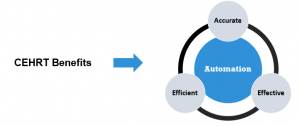
Dec 10, 2019 | Health eFilings, MIPS Reporting, Partner
Top Three Reasons CEHRT Reporting Will Earn More Points and Maximize Reimbursements
Guest Author: Sarah Reiter of Health eFilings
The Medicare Access and CHIP Reauthorization Act (MACRA) and the program designed to implement the law, Merit-based Incentive Payments Systems (MIPS), have raised the financial stakes and the complexity of regulatory compliance for all healthcare systems. Simply put, healthcare organizations, like yours, have no choice but to engage and embrace the shift to value-based care to improve outcomes and therefore maximize your reimbursements.
And the method of reporting for the MIPS program can have a significant impact on your ability to earn points. Not all reporting methodologies are the same. There are BIG differences between MIPS reporting methods and what you don’t know could result in a 7% penalty increasing to 9% penalty for the 2020 Reporting Period, not to mention lost bonuses! The most effective, and most efficient, reporting methodology is known as Certified EHR Technology or CEHRT.
But why is CEHRT reporting the superior method? In this post, we will address the comparison of CEHRT reporting with the legacy “Registry” reporting method. Here are the top three reasons that working with a CEHRT, like Health eFilings, is the superior approach:
1. The software does all the work
Health eFilings’ ONC certified software is an “end to end electronic solution”. The software will extract, analyze and prepare the data in the most complete and accurate manner without requiring any administrative or IT support from you, the practice.

In contrast, registry reporting is fully a manual process and simply is a combination of purchased forms and a submittal vehicle. With a registry, the burden of all the administrative work is placed on staff and requires manual measure calculation and measure selection, all with no visibility to the measure benchmarks.
2. eCQMs earn more points
Health eFilings uses eCQMs (electronic Clinical Quality Measures) for purposes of reporting, and eCQMS offer more and better measures to optimize the points that can be earned. Almost all eCQMs have benchmarks that provide a clearer and more concise way to determine your performance and earn more points. As a point of insight, think of how points are earned as grading on a curve, where your actual performance percentage is irrelevant but what is relevant is the way that percentage compares to your peers, and my peers, it means all providers, regardless of specialty or geographic location, who submit data for that measure.
As a point of comparison, almost half of registry measures don’t have benchmarks which mean no matter how well you do on that measure, your score (or points earned) will be significantly limited, resulting in few overall points.
3. End-to-end electronic solution and earns bonus points
CMS has determined that the data submitted via technology is more complete and accurate, and because of this, CMS is incentivizing clinicians and practices by awarding them bonus points toward their MIPS score when they use a CEHRT like Health eFilings.
However, a registry is not a CEHRT and does not meet CMS’s definition of technology and as such does not provide verified accurate and complete data. Therefore, a registry provides no opportunity for any bonus points for the practice.
So, when complying with MIPS, it’s critical to utilize the reporting method that optimizes the points that could be earned and leverages technology to facilitate the ease, accuracy, and completeness of tracking and reporting to maximize the score. Reporting via a CEHRT like Health eFilings is the best approach because it optimizes the points that could be earned and therefore, maximizes Medicare reimbursements.
Beyond the inherent benefits of leveraging technology, working with Health eFilings has many advantages versus any other reporting methodology:
- Seamless integration with any EHR or billing system
- No IT or Administrative resources needed from the practice
- Tracks and reports for all MIPS categories
- Earn bonus points because Health eFilings is an “end to end electronic solution”
- A proprietary algorithm evaluates 9 million combinations to select the best quality measures to optimize the score
- Electronically submits all data to CMS
Is there anything I can still do for 2019 reporting?
Even though the end of the 2019 reporting period is quickly approaching, you do not need to accept that you must take the automatic penalty for this year. Health eFilings can support you with reporting for the 2019 reporting period and also advise you on your situation to set you up to be ready for the start of the 2020 reporting so you are able to optimize your score.
LEARN MORE
If you would like to stay up to date with recent happenings at EZClaim and more interesting articles, please click here to visit our blog page!

Dec 10, 2019 | Alpha II, Claims, Partner, Revenue
Getting Claims Right the First Time
Getting Claims Right the First Time. Contributed by Timothy Mills, Chief Growth Officer, Alpha II, LLC
The numbers are staggering. Industry averages report that nearly 20% of all claims are denied, rejected, or underpaid. And considering the cost to rework claims — not to mention even higher appeal costs — as many as 60% of returned claims are never resubmitted.
With figures like these, it’s no wonder medical practices continue to face intense financial pressure. As negotiated reimbursements stagnate and operating expenses like rent and salaries continue to increase, the struggle to maintain steady revenue becomes even more crucial. For many practices, conducting reviews of their revenue cycle workflow would show gaps in their claims process. The good news is – these gaps can be bridged with the help of emerging technology.
With a saturated market of coding, billing, and compliance solutions, how do you begin to find the right technology for your practice? When trying to improve revenue integrity, it is important to understand exactly what vendors offer. For example, consider the term “first-pass claims rate,” which is still used by some healthcare IT vendors to represent the number of claims initially accepted by payers. But what is often overlooked is the number of those initially accepted claims that will be denied or underpaid. A better question would be – what percentage of claims are getting paid the first time they are submitted?
The fact is, practices that do not employ the latest clinical coding and editing tools within their revenue cycle are leaving money on the table. This is revenue that is rightfully theirs but is being pursued at high, incremental costs. It’s time to rethink traditional denials management practices, move beyond the “first pass claims rate,” and embrace the future of denial prevention.
It’s your money. Go after it.
Still not convinced that investing in emerging clinical coding and editing software can save your practice money? Let’s see what relying on traditional denials management methods might really be costing you.
Each rejected, denied or underpaid claim represents earned revenue your practice is missing out on. Based on industry reports, the average cost to rework a claim has been pegged at more than $25, and appeal costs can skyrocket to over $100. It’s estimated that as many as two-thirds of all denied claims are recoverable. But practices often weigh the reimbursement amount of a claim against the cost to rework or appeal that claim. For smaller claims, many decide it just isn’t worth the effort, which is why getting claims right the first time should be the ultimate goal.
So how much are practices losing by simply correcting and resubmitting denied claims using traditional denial management methods? Let’s look at an example using figures from an actual mid-sized specialty practice. This practice submits 1,900 claims a month and the average claim is $150. They have a better-than-average denial/rejection rate of 10 percent. Even with that lowered rate, this practice is losing roughly $28,500 a month to unresolved denied claims. If two-thirds of those denied claims are recoverable, they stand to recoup $19,095 in reimbursements after the claims are corrected and resubmitted. Factor in the cost associated with reworking denied claims using the industry average of $25 per claim, and this practice is spending $4,750 in administrative charges alone to recover their own revenue. This brings their actual recovered revenue down to $14,155 per month or almost $170,000 annually. Investing in a comprehensive clinical coding and editing solution is still cheaper than what the practice spends per month when reworking denied claims.
The Alpha II Solution
Are you ready to submit precise claims the first time? Contact Alpha II, a leader in revenue cycle solutions. Our comprehensive clinical claim editing solution, ClaimStaker, covers the entire continuum of care, verifying claim data from the payer’s perspective and allowing for corrections prior to filing.
Check out our Denial Impact Assessment Calculator to see what your denials really cost your practice or contact us today for a free personalized Claims Assessment. See why ClaimStaker does more than clear claims. It gets claims paid.
We work hard to update our blog to keep you up-to-date on what’s happening in the field of medical billing software. If you have a topic you would like to see discussed, please contact us.

Dec 10, 2019 | Administrative Safeguards, Live Compliance, Partner
ONE patient complaint leads to $2.175 Million fine! AND 2 Years of OCR Monitoring.
Contributed by Jim Johnson, President of Live Compliance
One patient complaint, that’s all it takes. Have you ever read such headlines and doubted whether a small billing company or independent physician practice would ever face such seemingly insurmountable penalties? Actually, there should be no doubt! The Sentara Hospital violations are violations that every small billing company or independent physician practice would face, not just because Sentara is a hospital.
So what happened? In short, a complaint from an individual came from a person receiving a bill containing another individual’s billing statement. As a result of Sentara investigating this breach, Sentara reported a breach affecting 8 individuals, when in actuality, Sentara mailed 577 patient’s statements to the wrong addresses. This is an example of why you must perform and document a breach risk analysis as soon as you become aware of a potential incident. It is important that you understand what a breach is and the breach notification requirements.
The second issue discovered during the investigation revealed Sentara failed to have a business associate agreement in place with an entity that performed business associate services for Sentara. This reinforces the importance of having business associate agreements in place and your understanding that BAA’s are contracts that outline timeframes and provide your attestation to a satisfactory assurance of your ability to safeguard PHI among other things.
Maybe most importantly, you should know every complaint must be investigated by HHS/OCR. What that means is, if you improperly disclose protected health information, like sending a statement to the wrong patient, you, a billing company, must inform the covered entity (your client) and have a breach risk assessment completed to determine several key factors. Then the covered entity must take action based on these findings. If you haven’t completed an accurate and thorough security risk assessment prior to that, you could also be penalized under ‘willful neglect’. This category alone is $50,000 per violation!
In fact, Texas Health received a $1.6 million fine for improperly disclosing ePHI. Texas Health failed to comply with several HIPAA requirements including failure to perform the HIPAA Security Risk Assessment.
The fines are huge, but the reputational damage to your billing company and the covered entity is expensive and difficult to overcome.
What we do is keep this from ever being a worry for you! In fact, we have a 100% audit pass rate since 2010! For example, Live Compliance has easy to understand HIPAA breach notification training. We perform your security risk assessment and manage all your requirements, including business associates, in a clean, organized cloud-based portal.
Don’t risk your company’s future, especially when we are offering a FREE Organization Assessment to help determine your company’s status.
It’s easy, call us at (980) 999-1585, email me jim@LiveCompliance.com or visit LiveCompliance.com
Keep in mind, a business associate is a ‘person’ or ‘entity’. This means there is no billing company too small or too large to comply with the Federal HIPAA regulations.
LEARN MORE
Click here to read more informative articles from EZClaim and our partners.

Dec 10, 2019 | BillFlash, NexTrust, Partner, Revenue
9 Signs It’s Time to Outsource Your Medical Billing and Coding.
Contributed by James Easley, VP, Marketing of NexTrust, Inc
Should a practice outsource their billing and coding or manage it in-house? This is one of the most important business decisions for practices to get right. Which is the better option for your practice? Here are nine signs that it may be more financially beneficial to outsource medical billing.
1. Do You Lack Visibility into Billing and Payment Metrics?
Do you know your key financial metrics and how to improve them? Many practices are not aware of their actual revenue metrics which are the “vitals” for the financial health of their practice. For example, only about 35% of practices appeal denied claims, which means most are losing out on thousands of dollars every month.
Without the ability to measure these financial vitals, it’s difficult to know how to improve. Does your practice have a financial analyst as well as the staff with the skills to identify problems and make improvements? If not, practices should consider looking at external experts to provide these metrics and are able to make the necessary billing improvements.
2. Is Your Revenue Decreasing?
For practices that are aware of their billing and payment metrics, are you seeing your collections decrease? Is the time it takes to collect increasing? Unfortunately, this is more and more common among practices due to the ever-changing complexity of the insurance billing processes. Outsourcing is not the only solution, however fixing this problem internally can often be costlier and time-consuming than outsourcing.
You need a solid income stream to keep your clinic operating effectively. If billing mistakes, coding complexities, and reduced reimbursements or denials have negatively affected your collections, then you need to consider outsourcing your billings and collections to keep your company from falling victim to a bad revenue stream.
Not only does this keep your business running optimally, but it also allows your personnel to focus on other responsibilities and ensure quality customer service.
3. Are Billing Errors and Rejected Claims Costing You Money?
The American Academy of Family Physicians reports that a 5-10% denial rate is the industry average. To be financially sound, practices should do what’s necessary to keep this rate below 5%. Because high claim denial rates require additional costs and staff time to correct and resubmit, many practices have found the outsourcing resolves this issue and provides higher net income overall.
4. Are You at Risk of Staff Absence or Turnover?
While every industry faces the challenges of staff turnover, the effects are often felt acutely among medical practices when billers leave. Since claim processing is integral to the lifeblood of a practice, replacements or new additions to your billing department unavoidably result in a slowdown in claims processing. Practices can remove this variability and risk through outsourcing their billing and pushing the staffing burden to the third-party. Practices then rely on a team that can ensure the work of claim processing continues without interruption.
5. Are Staff Billing and Coding Skills and Training Insufficient?
Many practices take on the responsibility of hiring, managing and training Internal billing and coding staff. This works well in many practices. However, if billing and coding staff is under-experienced or not current on compliance and regulatory issues, practices must cost-effectively provide regular training to get and keep them current. Practices that prefer not to take on these burdens can find a simple solution in outsourcing.
6. Has In-house Billing Become Too Expensive?
Considering the costs of hiring, salary, benefits and administrative costs of in-house medical billers, practices may find it costs less overall to outsource their billing.
In addition to employee costs, practices must purchase equipment, software, and more. In-house billing costs can quickly add up. Practices should compare internal costs to outsourcing to determine both the best operational and cost-effective methods for billing and coding management.
7. Do You Have New Providers or a New Practice?
Newer practices may find it difficult to navigate the complexities of medical billing and coding. These new practices or practices with new providers need to ensure they are focused on growing their business and providing a high level of care.
Delegating important responsibilities to a trusted third-party allows new practices and providers to do just that. Outsourcing your medical billing during this time can relieve the burdens of hiring, training or managing a team of new billing employees.
8. Is Your Clinic Growing?
A growing practice can have similar challenges as a new clinic. Reputation is critical when growing your business and ensuring high-quality patient attention and care can become more difficult.
As your staff will likely be tasked with more responsibilities and duties during this growth period, why not ensure they can still provide meaningful services by taking some of those administrative duties off their hands. Your personnel will thank you for this by continuing to provide quality care to patients, which in turn will help you to continue growing.
9. Is Your Attention Divided Between Patients and Running a Business?
Overseeing internal billing and coding requires a substantial amount of effort, time, and expertise. Without dedicated staff to handle this, the responsibility can fall on the shoulders of clinic owners, physicians, or other administrative staff.
This can mean less time focusing on patients or other relationships and practice management responsibilities. When practices outsource the billing process, physicians and administrators are free to focus on providing quality healthcare services to patients.
If you found yourself nodding your head to one or more of these questions, it’s worth taking some time to learn if outsourcing would be better for your practice. NexTrust offers both patient and insurance billing services that not only improve revenue but allow providers and staff to focus on providing the highest level of care.
Free $25 gift card with RCM demo
Call NexTrust today 435-940-9123 or email us at rcm@billflash.com to learn how our Patient Billing and Insurance Billing services can improve the financial health of your practice.
Stay tuned to our blog for the latest information related to the medical billing field from EZClaim and our esteemed partners.

Dec 10, 2019 | EZClaim Premier
Written by Stephanie Cremeans and Allison Close of EZClaim
What kind of device are you reading this on? Perhaps on your computer in the office or a laptop at the beach. Maybe a tablet or even a smartphone. Let’s think about that smartphone – isn’t it crazy how much it allows us to do? Anything from calls, texts, email, browsing the web, games, and even conduct business online. Now take a minute to rewind. Do you remember your first cell phone? Many of you may remember bag phones – with a cord and carrying case that you had to lug around. Then came the flip phones – first, they got smaller, then they got bigger, then they started adding cameras, data packages, and streaming capabilities. The cellphone market has been one of constant change, but we can all agree that technology has given us amazing tools to keep us connected, entertained, and productive!
Remember when smartphones started coming out? The “early adopters” were so excited to turn in their flip phones and begin taking advantage of everything the latest technology had to offer. We still see that excitement with pre-orders of the latest and greatest version of a new phone. However, many of us didn’t want to spend the money or take the time to learn these new devices; what we had worked just fine. We could make and receive calls, and we were pretty good at texting with a numeric keypad. At some point along the way, something caught our attention on that silly new gadget. Someone showed us a feature that made us think “hmm … maybe I would like that” or we found that our old device was showing its age and when we went to replace it, we had to upgrade to a phone with more bells and whistles than we would ever need. As time went on and you learned some tricks to help you out, the new device grew on you because it provided personal benefits. You realized that even though the flip phone was all you ever needed and it was what you always used, there is a new technology that worked, well, better.
Change can be scary. Especially when you don’t see the need for it. We often hear “but we’ve always done it this way” only to discover that each element of the current workflow was put into place by various decision-makers (provider, office manager, consultant) along the way, with no true coordination, minimal (if any) efforts to streamline or consolidate processes, and no regular evaluation mechanism to keep an eye on the big picture. We would like you to allow us to present our improved software, Premier. While what you have is already working, just the way you’ve always done it – what else could be waiting for you to make your process faster and smoother? The demonstration has no strings attached. No high-pressure pitch to move systems, we would just like an opportunity to show off the products we have worked so hard on to help your billing workflow with various integrations and many options for customization. We will be sunsetting our Advanced program at the end of 2020. Although the program may still be working perfectly for your practice, how do you know if it can be improved with Premier unless you take a look, see what’s there – even take it for a test drive with our Sandbox trial. We’re confident you will find that feature that will have you thinking, “hmm … maybe I would like that.”
We invite you to take a look at EZClaim Premier – participate in a demo or download your free 30-day trial.







